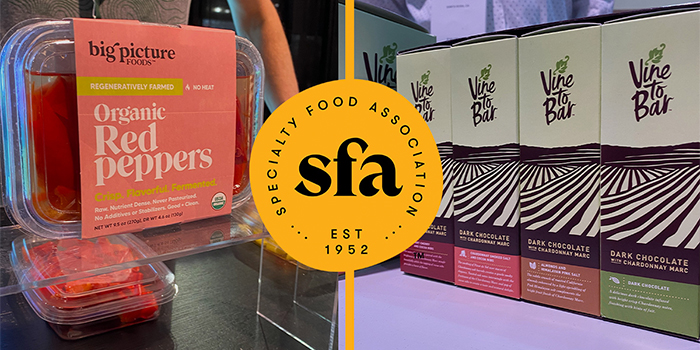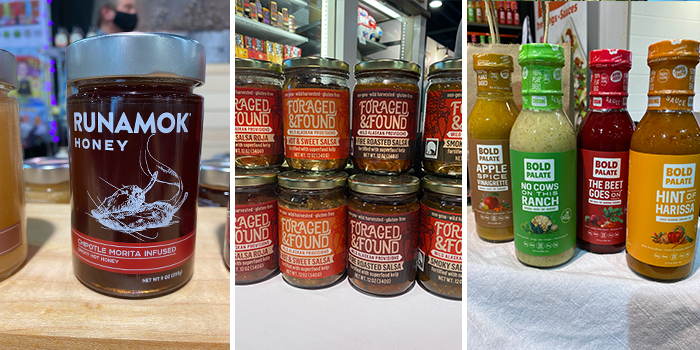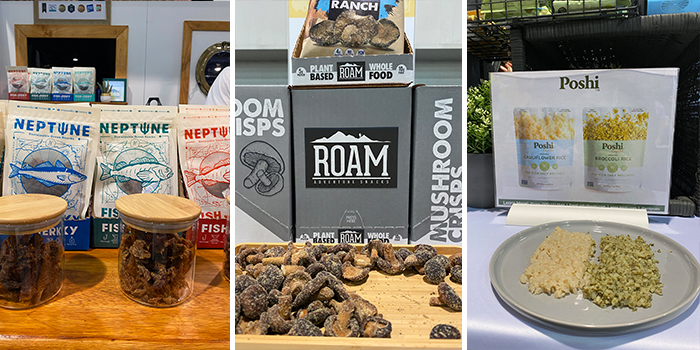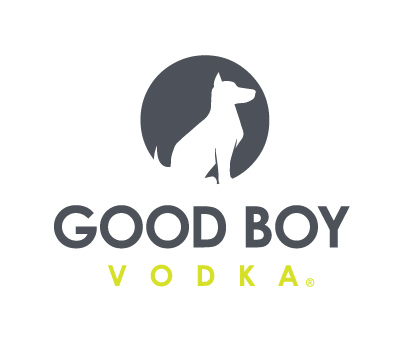Fancy Foods Notebook: Brands Boast Strong, Sustainable Supply Chains and Rethink Commodities

After two years of virtual events and pandemic-induced supply chain disruptions, an in-person return to the Specialty Food Association’s Winter Fancy Foods show brought an eagerness to boast about the people and processes behind each product. While every food and beverage brand has been subject to challenges over the past two years, many displayed a sense of pride in every unique supply chain approach. Exhibitors presented a variety of new flavor and nutrition profiles, shared the benefits of small-farming regenerative networks and displayed new creations using upcycled side-stream ingredients.
Many of the emerging brands in attendance aimed to take new approaches to overlooked and under-innovated categories while the more well-established exhibitors also maintained a pulse on consumer interests by sharing ingredient origins, sustainable production practices and better-for-you innovations.

Sustainability Drives Pantry Staple Innovation
Amidst the new products unveiled at the show, sustainability and climate impact were two dominant themes between new brands and products with many calling out these attributes directly on front-of-pack.
First time exhibitor, Big Picture Foods took to the show floor with the expressed goal of modernizing commodities such as marinated olives and peppers. The brand also aims to increase attention toward the environmental impact of conventionally-farmed pantry staples and has placed its naturally fermented food line not in the center store, but the fresh set of over 300 natural and independent grocers nationwide.
The brand’s co-founder and Head of Marketing, Daniela Jensen said this added visibility helps distinguish the company as a raw, unpasteurized alternative. The products have a 2-year, refrigerated shelf-life and the brand currently sells a line of regeneratively farmed organic olives and debuted its specialty fermented pepper line at the show.
Alaska-based Foraged & Found, a “wild harvested” sauce and condiment brand, is also looking to reinvigorate center-store with product lines that include native Alaskan superfood ingredients such as bull kelp and sea asparagus. What began as “an accident” said founder Jenn Brown, has grown into a regional brand determined to go national while also rethinking commodities such as pickles, salsa and sauces by incorporating sustainably-sourced superfood ingredients. The result – a nutrient-dense pantry staple and only a hint of brine-y flavors.
In terms of supply chain, this brand is literally foraging and finding its ingredients in the Alaskan wilderness. Utilizing wild harvesting techniques, Brown said the end-goal is to bring the unique nutrition and flavor profiles of wild Alaskan ingredients to stores across the country while leaving the wilderness “untouched.”

New Approaches To Snacking
Sea-faring products were not necessarily commonplace at this year’s fancy food show, but maker Neptune Snacks also stood out on the floor for its sustainable, wild-caught fish jerky, sourced from local fishermen. The Neptune team also hinted that a dive into the seaweed category may be imminent, stating that a plant-based, ocean-oriented jerky is a high priority in its innovation pipeline.
Aside from jerky, better-for-you snack brands and chip alternatives were definitely not in short supply. Notable new innovations include nopal cactus stick maker Nemi Holisticks and mushroom crisp brand Roam Snacks which both made their respective debuts in the Incubator Village. Among them were numerous other vegetable-forward snack makers such as Root Foods, Canada-based Hardbites and Rhythm Foods.
Even within better-for-you segments like plant-based and vegan products, many exhibitors embraced indulgence, including plant-based cookie dough bar maker Woah Dough, which is working to expand its distribution footprint outside of the Midwest, and vegan cookie dough cups Yummy Doh, a Canada-based food brand aiming to expand to the U.S..
However, the most distinguished among new indulgent treats may have been Vine to Bar – a chocolate company upcycling leftover grape byproducts created during winemaking processes. The brand currently sells tasting squares, full-sized bars and chocolate-covered almonds, all infused with the brand’s flagship WellVine Chardonnay Marc ingredient, created from leftover grapes. The end result is a nutrient-dense, flavanol-rich dark chocolate with unique flavor profiles such as tart cherry and smoked chardonnay salt.
Also distinguishing on the basis of flavor innovation is Vermont-based Runamok which introduced a range of new infused honey products at this year’s show with flavors such as hibiscus, lemon verbena, chipotle morita and szechuan peppercorn. The maple syrup producer prides itself on its in-house supply network, originally operating as a maple syrup distributor until it “put a brand to the ingredient,” first partnering with local distilleries to create barrel-aged syrups and now producing lines of syrups, honeys, cocktail mixers and a co-branded whiskey which will be on-shelf at Whole Foods later this year.
Supply Chain Questions Remain
As the COVID-19 pandemic approaches the two-year mark, there were signs that – despite the winter omicron surge – that the industry has stabilized. However, supply chain dynamics remain in flux and are expected to remain so for at least the first several quarters of this year. As such, brands and entrepreneurs are rethinking not only the logistics of sourcing and securing ingredients, but also examining how supply chain strategy fits into broader goals around sustainability and mission.
For brands sourcing ingredients outside of the U.S., those dynamics have been increasingly difficult. Heirloom fruit and nut brand Ziba Foods procures its ingredients from small-scale, women-run farms in Afghanistan. While a spokesperson for the brand said political unrest in the country presented additional challenges on top of existing transportation constraints and import delays, she noted that the brand’s close relationship with its network has allowed them to navigate those issues and avoid facing inventory shortages.
Whether it’s to source a commodity crop like wheat or dairy or securing a specialty ingredient such as saffron and figs, there appears to be an increased realization among brands of the value of establishing or utilizing existing small farming networks. From sustainability plays to increased efficiency the majority of exhibitors highlighted their respective supply chain’s impact on not only the end-product, but also their brand’s values and mission.





















